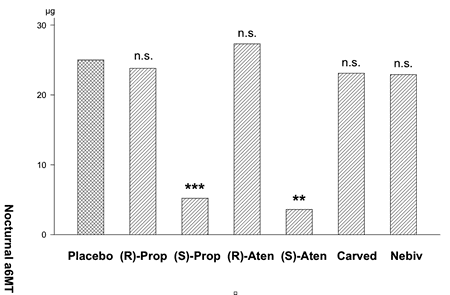Beta-blockers derive their names from their main pharmacodynamic action, i.e., their inhibition of the stimulating effects of katecholamines on sympathetic beta-adrenoceptors.
However, there are some “special” beta-blockers that exert additional effects completely independent from their affinity to beta-receptors. Those are particularly Nebivolol, Carvedilol, Sotalol and Propranolol (Table).
Nebivolol is one of the “youngest members” in the family of beta-blockers widely used in clinical practice. Actually, Nebivolol is the drug with the highest beta1-selectivity (1). In addition, Nebivolol causes
NO-derived vasodilation which has been shown in humans by a marked increase in forearm blood flow that is completely abolished by coinfusion of L-NMMA, a specific inhibitor of NO-synthase (2). This vasodilating effect has clear clinical relevance since it has been shown that the beta-blocking potency of 5 mg Nebivolol is comparable to that of 25 mg Atenolol, whereas the blood pressure lowering effect of 5 mg Nebivolol is comparable to that of 100 mg Atenolol (3).
As a further feature, it was shown that Nebivolol does not decrease nocturnal melatonin release (4) which is a common side effect of most other beta-blockers as shown with Propranolol and Atenolol (5) (Figure). Since a decrease in nocturnal release of melatonin may be one reason of sleep disturbances, a common side effect of beta-blockers of the first and second generation, this finding observed with Nebivolol (and Carvedilol, see below) might be of practical importance in order to avoid this adverse effect.
In addition, plasma concentrations of Nebivolol do not increase during exercise (6), thus indicating that Nebivolol is not taken up into, stored in and released from adrenergic cells during exercise together with adrenaline and noradrenaline, a common feature of most other beta-blockers such as Propranolol and Atenolol (7) which might explain why these beta-blockers may still be effective after withdrawal of therapy even when they are no longer detectable in plasma.
Carvedilol is a non-specific antagonist of adrenergic beta1- and beta2-receptors with additional blocking effects on adrenergic alpha1-receptors (8). Thus, this drug exerts an additional effect independent of beta-blockade that, on the one hand, increases its blood pressure lowering effect and, on the other hand, may decrease potential side effects resulting from beta-blockade since the decrease of blood pressure caused by alpha-blockade may cause a reflectory increase of sympathetic tone thus reducing beta-blocking (side) effects such as bradycardia, bronchial constriction, impotence, etc.
Furthermore, Carvedilol does not reduce nocturnal melatonin release (5), a finding unique to Carvedilol and Nebivolol among all beta-blockers so far investigated on this issue (4) (Figure).
In addition, plasma concentrations of Carvedilol do not increase during exercise (9,10), thus one more finding unique to Carvedilol and Nebivolol among all beta-blockers so far investigated.
Sotalol is a non-selective, hydrophilic beta-blocker which prolongs cardiac repolarisation independent of its antiadrenergic action, thus representing class III antiarrhythmic properties (11).
Just like all other beta-blockers currently used in cardiovascular medicine, Sotalol is a racemic mixture consisting of equal amounts of d-Sotalol and l-Sotalol, with the d-enantiomer showing solely antiarrhythmic class III effects and the l-enantiomer exerting both antiarrhythmic class III and beta-blocking effects (12,13). Thus, racemic Sotalol is a combined beta-blocking and antiarrhythmic class III agent that may be useful in the treatment of both ventricular and supraventricular arrhythmias (11,14). The importance of this finding has been emphasised in the SWORD study (15) that was terminated prematurely because d-sotalol – the optically pure d-enantiomer that only exerts antiarrhythmic class III effects but no beta-blockade increased all-cause mortality compared to placebo by 65 % (p = 0.006), mainly due to arrhythmic deaths. Thus, antiarrhythmic class III properties may be useful in order to increase the antiarrhythmic efficacy of Sotalol. However, beta-blockade (effected exclusively by the l-enantiomer) appears to play a major role in the efficacy and safety of Sotalol.
Propranolol is a non-selective, lipophilic beta-blocker with two additional features: On the one hand, only the non-beta-blocking d-enantiomer inhibits the conversion of thyroxin to triiodothyronin, whereas only the l-enantiomer shows beta-blocking effects (16,17). Thus, a major part of the efficacy of Propranolol in patients suffering from hyperthyroidism resides exclusively in the non-beta-blocking d-enantiomer. This effect on thyroid hormones is well achieved with generally recommended doses of Propranolol in humans.
On the other hand, Propranolol has been shown to exert antiarrhythmic class I effects residing equally in both the d- and l enantiomers (18). However, only slight antiarrhythmic class I effects can be achieved even with the highest recommended doses of Propranolol in humans.
Regarding these additional effects of “special” beta-blockers such as Nebivolol, Carvedilol, Sotalol and Propranolol, one should always bear in mind that beta-blockers may exert a number of interesting features in addition to their well known effects on cardiac beta-adrenoceptors.
Table: Particular features of “special” beta-blockers
Beta-blocker Particular feature(s)
Nebivolol
High beta1-selectivity
NO-derived vasodilation
No effect on nocturnal melatonin release
No release from adrenergic cells
Carvedilol
Inhibition of sympathetic alpha1-receptors
No effect on nocturnal melatonin release
No release from adrenergic cells
Sotalol
Antiarrhythmic class III effects
Propranolol Inhibition of the conversion of T4 to T3
Slight antiarrhythmic class I effects
Figure

Effects of oral doses of 40 mg (R)-Propranolol, 40 mg (S)-Propranolol, 50 mg (R)-Atenolol, 50 mg (S)-Atenolol, 25 mg Carvedilol racemate and 5 mg Nebivolol racemate on nocturnal excretion of 6-Sulfatoxy-Melatonin (a6MTS, the main metabolite of melatonin that is almost completely released in urine): The beta-blocking (S)-enatiomers of Propranolol and Atenolol decreased aMT6s by more than 80 %, whereas the non-beta-blocking (R)-enantiomers of Propranolol and Atenolol as well as the racemic mixtures of Carvedilol and Nebivolol had no effect.
**, p < 0.01
***, p < 0.001; n.s., not significant (compared to placebo)
The content of this article reflects the personal opinion of the author/s and is not necessarily the official position of the European Society of Cardiology.


 Our mission: To reduce the burden of cardiovascular disease.
Our mission: To reduce the burden of cardiovascular disease.